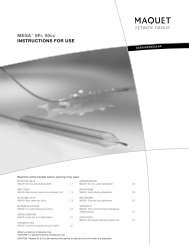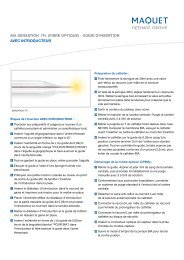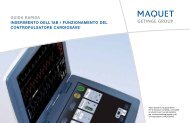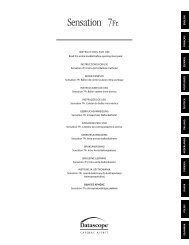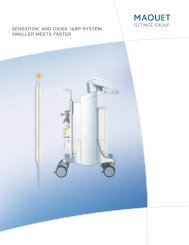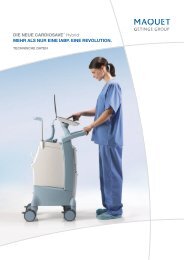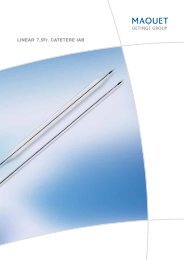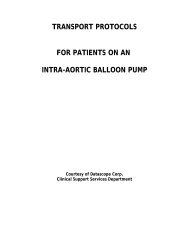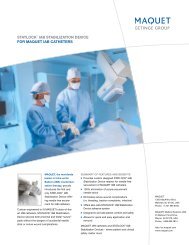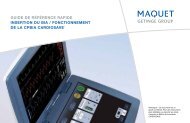Instructions for Use FidelityTM 8Fr. Intra-Aortic Balloon Catheter 9.5 ...
Instructions for Use FidelityTM 8Fr. Intra-Aortic Balloon Catheter 9.5 ...
Instructions for Use FidelityTM 8Fr. Intra-Aortic Balloon Catheter 9.5 ...
Create successful ePaper yourself
Turn your PDF publications into a flip-book with our unique Google optimized e-Paper software.
6<br />
PS<br />
BA L ON<br />
WARNING: If you do not use fluoroscopy during IAB catheter Insertion, you MUST<br />
take an X-ray as soon as possible to ascertain that the IAB catheter is properly<br />
positioned.<br />
<strong>9.5</strong> Fr. True Sheathless IAB<br />
<strong>Catheter</strong> Body<br />
Sleeves<br />
Retaining label<br />
<strong>Catheter</strong><br />
Pull iab catheter straight out<br />
Figure 4<br />
PRECAUTIONS:<br />
• Do not remove IAB catheter from tray until immediately prior to inserting over<br />
guide wire.<br />
• Remove the IAB catheter from the tray by pulling STRAIGHT out to avoid<br />
difficulty removing it from the tray or to avoid damaging it.<br />
• Take care not to kink or place undue <strong>for</strong>ce on the IAB catheter.<br />
16. Remove the IAB catheter by lifting the Y-fitting and catheter from the tray.<br />
17. Withdraw the balloon membrane from the protective sleeves by PULLING THE<br />
IAB CATHETER STRAIGHT OUT OF THE SLEEVES THROUGH THE SLOT PROVIDED IN<br />
THE TRAY. (See Figure 4.) THE SLEEVES AND RETAINING LABEL ARE NOT<br />
PART OF THE IAB CATHETER AND SHOULD REMAIN ATTACHED TO THE TRAY.<br />
18. If fluoroscopy is not used, measure the distance from the angle of Louis or<br />
between the second and third intercostal space extending down to the<br />
umbilicus and then obliquely over to the femoral insertion site. Slide the sheath<br />
seal or Sheathless GARD protector up the catheter to this measured distance.<br />
19. Lubricate the IAB catheter by passing it through a basin of sterile saline solution.<br />
20. Remove the stylet wire from the inner lumen (Figure 5). Do not attempt stylet<br />
reinsertion.<br />
21. Manually flush inner lumen with 3-5 cc flush solution.<br />
Stylet wire<br />
Stylet cap<br />
Female luer hub<br />
Figure 5<br />
22. Insert guide wire through the inner lumen (See Figure 6.) Advance the IAB<br />
catheter over the guide wire until the guide wire exits the female luer hub.<br />
Always ensure the operator has complete control of the guidewire.<br />
Precaution: When using a chest X-ray to identify the location of the IAB <strong>Catheter</strong>, it<br />
is best to place the IABP in stand-by to improve visualization while the X-ray is<br />
taken and then immediately resume pumping.<br />
A2. WHEN USING INTRODUCER SHEATH<br />
WARNING: If the balloon membrane has not entirely exited the introducer sheath, it<br />
will not inflate and deflate properly.<br />
NOTE: Either during advancing or once the catheter is correctly positioned; confirm that the IAB<br />
catheter membrane has fully exited the sheath. See Figure 8.<br />
FIRST SINGLE MARK<br />
Entire <strong>Balloon</strong> Membrane has<br />
Left 6" (15.2 cm) Introducer<br />
Sheath<br />
End of <strong>Balloon</strong> Membrane<br />
6" (15.2 cm) Introducer<br />
Sheath<br />
Figure 8<br />
1. The first single band from the IAB catheter tip indicates that the entire balloon<br />
membrane has exited from the 6” (15.2 cm) introducer sheath/hemostasis valve<br />
and may now be inflated.<br />
2. Single bands follow at 3/4” (1.9 cm) increments.<br />
3. A double band indicates that the entire balloon membrane has existed from the<br />
11” (27.9 cm) introducer sheath/hemostasis valve (10.5 Fr. IAB’s only) and may<br />
now be inflated.<br />
25. Maintain sterility of the exposed catheter until the proper IAB catheter position is<br />
verified.<br />
26. After proper placement of the IAB <strong>Catheter</strong>, push the Universal Sheath Seal as<br />
close to the insertion site as possible. (See Figures below)<br />
NOTE: If blood is seen passing the sheath seal following insertion through a sheath, disengage<br />
sheath seal from hemostasis valve.<br />
Skin line<br />
1<br />
Fidelity 8 Fr. IAB<br />
Universal sheath seal<br />
3<br />
2<br />
DOUBLE MARK<br />
Entire <strong>Balloon</strong> Membrane has Left<br />
11" (27.9 cm) Introducer Sheath<br />
11" (27.9 cm) Introducer Sheath<br />
(10.5 Fr. IAB Only)<br />
Stat sleeve<br />
BA L ON<br />
Hemostasis Valve<br />
Hemostasis Valve<br />
Sheath Seal<br />
Push the sheath seal down over the hemostasis valve hub.<br />
10.5 Fr. Percor STAT-DL IAB<br />
Sheath Seal<br />
<strong>Catheter</strong> Body<br />
Push the sheath seal down over the hemostasis valve hub.<br />
If it becomes necessary to reposition the IAB catheter, hold the sheath seal in one<br />
hand, grasp the catheter through the STAT-GARD sleeve with the other hand, and<br />
reposition under aseptic conditions. Do not attempt to reposition the IAB catheter by<br />
moving the sheath.<br />
B. INITIATING IAB PUMPING (IABP)<br />
NOTE: Do not raise the head of the bed greater than 45°.<br />
1. After positioning the IAB catheter, remove the guide wire.<br />
2. Once the catheter is in place, aspirate and discard 3cc of blood from the inner<br />
lumen and then immediately per<strong>for</strong>m a manual flush using a<br />
syringe filled with 3 cc to 5 cc of flush solution. This will minimize the chances of<br />
stagnant blood clotting in the inner lumen.<br />
NOTE: If you are not using the inner lumen <strong>for</strong> pressure monitoring, aspirate 3cc of blood from the<br />
nner lumen and cap the female luer hub with the supplied luer cap.<br />
WARNING: NEVER INJECT AIR INTO THE INNER LUMEN (female luer hub).<br />
3. Release the vacuum from the IAB catheter by removing the one-way valve from<br />
the IAB catheter male luer.<br />
4. For Fidelity 8 Fr. IABs only, after IAB insertion has been completed, remove the<br />
Gas Lumen Insert by loosening the one-way valve from the extracorporeal<br />
tubing’s male luer and slowly withdraw the Gas Lumen Insert from the gas<br />
passage of the IAB catheter (See Figure 9).<br />
One-way valve<br />
IAB catheter tip<br />
Skin line<br />
Gas lumen insert<br />
Male luer fitting<br />
Extracorporeal tubing<br />
Figure 6<br />
Guide wire<br />
WARNING: Do not use excessive <strong>for</strong>ce when inserting the IAB catheter. If you use<br />
excessive <strong>for</strong>ce when inserting the IAB catheter, arterial tearing, dissection, or balloon<br />
membrane damage may occur.<br />
NOTE: During insertion of the IAB catheter, arterial blood under pressure may run down the length<br />
of the folds in the balloon membrane and drip or be expelled under arterial pressure from<br />
the balloon membrane/catheter junction. THIS “CHANNELING” IS NOT A LEAK. As the IAB<br />
catheter is advanced the bleeding will diminish.<br />
23. While controlling the proximal end of the guide wire, advance the IAB catheter<br />
over the guide wire into the artery. Always grasp the IAB catheter no more<br />
than one inch (2.5 cm) from the insertion site or sheath hub and advance<br />
in short continuous strokes to avoid kinking the IAB catheter while<br />
maintaining complete control of the guidewire.<br />
PRECAUTIONS:<br />
• Always advance in short, continuous, one inch (2.5 cm) strokes to avoid kinking<br />
the IAB <strong>Catheter</strong>.<br />
• DO NOT twist the catheter during insertion.<br />
WARNINGS:<br />
• Any kinking or damage to the inner lumen may result in subsequent fatigue<br />
failure to the inner lumen when pumping.<br />
• Do not insert the IAB catheter unless the inner lumen is supported by a<br />
guidewire.<br />
24. Advance the IAB catheter to the proper position in the descending thoracic<br />
aorta, with the IAB catheter tip just distal (approximately 2 cm) to the left<br />
subclavian artery. (See Figure 7)<br />
Left<br />
subclavian<br />
artery<br />
2 cm<br />
IAB catheter tip<br />
Maximum distance possible<br />
<strong>Aortic</strong>-iliac<br />
bifurcation<br />
<strong>Catheter</strong><br />
Femoral artery<br />
Suture pads<br />
WARNING: Do not insert any portion of the Universal Sheath Seal below the skin line.<br />
<strong>9.5</strong> Fr. True Sheathless<br />
Sheathless GARD TM<br />
Protector<br />
Skin Line<br />
Stat GARD TM Sleeve<br />
Femoral Artery<br />
Suture Pads<br />
Sheath Seal<br />
WARNING: Do not insert the Sheathless GARD protector into the subcutaneous tissue.<br />
A3. INSTRUCTIONS FOR USE OF SHEATH SEAL WITH<br />
INTRODUCER SHEATH<br />
PRECAUTION: Do not place any sutures or ligatures around the outside diameter of the<br />
Introducer to avoid kinking or damaging the sheath.<br />
Fidelity 8 Fr. IAB<br />
Hemostasis valve<br />
Stat GARD TM Sleeve<br />
Universal sheath<br />
seal<br />
Push the Universal Sheath Seal into the hub of the introducer sheath.<br />
Figure 9<br />
5. Connection of the IAB catheter to the pump.<br />
NOTES:<br />
• Ensure that all connections are leak-free.<br />
• All catheter extenders are sterile and should only be used one time.<br />
• <strong>Use</strong> one catheter extender when connecting the IAB catheter to the IAB pump.<br />
a. When a Datascope IAB pump is used: Connect the IAB catheter’s male luer<br />
fitting to the female luer fitting of the catheter extender. Connect the male<br />
luer fitting of the catheter extender to the safety chamber/disk.<br />
b. When an Arrow IAB pump is used: Connect the IAB catheter’s male luer<br />
fitting to the female luer fitting of the Arrow catheter extender, then connect<br />
the catheter extender to the appropriate system. Adjust the volume setting<br />
on the Arrow pump, according to the operating instructions, to match the IAB<br />
catheter volume.<br />
NOTE: Prior to using the Arrow catheter extender, remove the protective tubing from the pins.<br />
6. Follow the IAB pump operating instructions to initiate pumping. If augmentation<br />
is not within the desired range, see Appendix A, Factors Affecting<br />
Augmentation.<br />
7. If after a few cycles of counterpulsation, it appears that the balloon membrane is<br />
not fully open, per<strong>for</strong>m the following procedure:<br />
WARNING: Do not per<strong>for</strong>m manual inflation of the IAB with the catheter extender<br />
tubing attached to the IAB catheter.<br />
a.<br />
b.<br />
Detach the catheter extender from the IAB catheter’s male luer fitting.<br />
Attach the supplied 3-way stopcock and syringe to the IAB catheter’s male<br />
luer fitting.<br />
WARNING: NEVER INJECT AIR INTO THE INNER LUMEN (female luer hub).<br />
c. Aspirate to assure blood is not returned through the extracorporeal tubing.<br />
WARNING: If you aspirate blood from the male luer fitting of the extracorporeal<br />
tubing, immediately remove the IAB catheter as damage may have occurred to<br />
the balloon membrane during insertion.<br />
d. Inflate the IAB with air or helium, as follows, and IMMEDIATELY aspirate:<br />
Figure 7<br />
P/N 0065-00-0683-02 R0<br />
IAB <strong>Catheter</strong> Volume<br />
25 cc.<br />
34 cc , 40 cc or 50 cc.<br />
Inflate Volume<br />
50 cc.<br />
60 cc.



